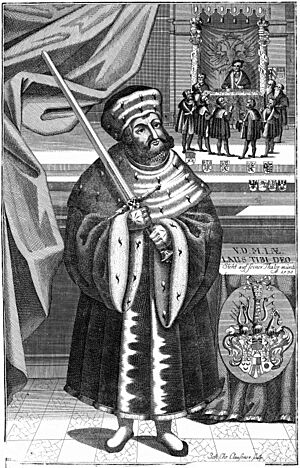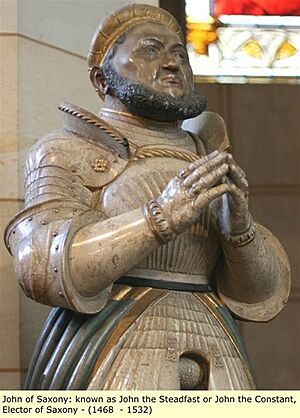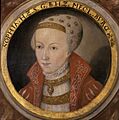John, Elector of Saxony facts for kids
Quick facts for kids John |
|
|---|---|
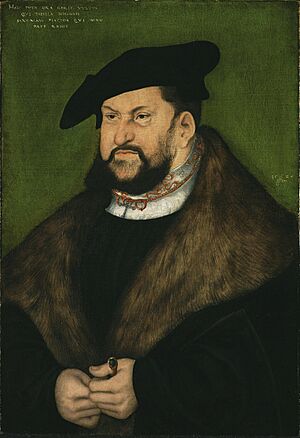
Portrait by Lucas Cranach the Elder, 1526
|
|
| Elector of Saxony | |
| Reign | 5 May 1525 – 16 August 1532 |
| Predecessor | Frederick III |
| Successor | Johann Frederick I |
| Born | 30 June 1468 Meissen, Electorate of Saxony, Holy Roman Empire |
| Died | 16 August 1532 (aged 64) Schweinitz, Electorate of Saxony, Holy Roman Empire |
| Burial | Schlosskirche, Wittenberg |
| Spouse |
Sophie of Mecklenburg-Schwerin
(m. 1500; died 1503)Margaret of Anhalt-Köthen
(m. 1513; died 1521) |
| Issue Detail |
Johann Frederick I, Elector of Saxony Maria, Duchess of Pomerania John Ernest, Duke of Saxe-Coburg |
| House | House of Wettin |
| Father | Ernest, Elector of Saxony |
| Mother | Elisabeth of Bavaria |
| Religion | Roman Catholic (1468–1525) Lutheran (1525–1532) |
John (born 30 June 1468, died 16 August 1532) was also known as John the Steadfast or John the Constant. He was an important ruler called the Elector of Saxony from 1525 until 1532. He belonged to the House of Wettin, a powerful family.
John is famous for helping to organize the Lutheran Church in Saxony. He worked closely with Martin Luther, who was a key leader of the Protestant Reformation. Luther's ideas for the church were used in Saxony and then spread to other parts of the Holy Roman Empire. John provided leadership and money for the new church after it separated from the Roman Catholic Church.
He also played a part in a major event called the Protestation at Speyer, where Protestant leaders stood up for their beliefs.
Contents
John's Life Story
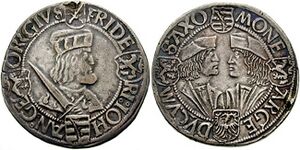
John was born in Meissen. He was one of seven children born to Ernest, Elector of Saxony and Elisabeth of Bavaria.
From 1486, he was expected to become the next Elector because his older brother, Frederick the Wise, had no children. John received some family wealth and helped his relative, Maximilian I, Holy Roman Emperor, in several wars.
When his brother Frederick died in 1525, John became the Elector. He was a strong supporter of Martin Luther and quickly became a leader among the Protestant reformers. His nickname, "The Steadfast," shows that he firmly continued his brother's work to protect the Protestant Reformation.
Supporting the Reformation
In 1525, John helped stop an uprising during the German Peasants' War. After that, he worked with Philip I, Landgrave of Hesse, to create the League of Gotha in 1526. This group was formed to protect the reformers.
John was very active at the Diet of Speyer in 1526. He signed a protest against the decisions made there. This gave him the chance to change the church in Saxony. Martin Luther helped create a plan for church services.
So, in 1527, the Lutheran Church became the official church in Ernestine Saxony. John, as the Elector, became the main leader of the church. He made sure that Lutheran beliefs were followed. He also ordered that priests who stayed Catholic be removed and that church services be held in the local language, as Luther suggested.
John was also a leader of the Schmalkaldic League. This was a group of Protestant states formed in 1530 to defend the Reformation. He also agreed to the Nuremberg religious peace in 1532, which aimed to bring peace between Protestants and Catholics.
John's Character and Beliefs
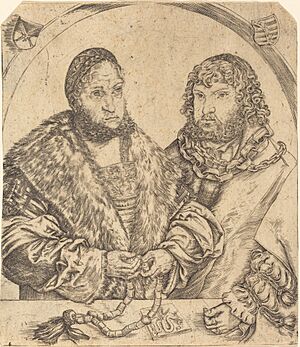
John had the same positive view of the Reformation as his older brother. His strong will and bravery in sticking to his religious beliefs made him well-known. His Christian faith guided his political choices, which many people thought were very fair.
In politics, he was sometimes slow to make decisions. He worked closely with Philip I of Hesse because they shared the same religious beliefs. Philip often pushed for a more active foreign policy, while John was more focused on whether Protestants should defend themselves against the Emperor.
His Relationship with Martin Luther
As a supporter of Martin Luther, John had a very close and friendly relationship with him. Luther often spoke highly of John, especially for his actions at the Diet of Augsburg in 1530. Luther praised him, saying that John had the "Holy Spirit" and showed it by standing firm in his faith. John even said, "Tell my scholars that they are doing what is right, praise and honor God, and take no regard for me or my country."
John was so committed to the Protestant faith that he would even remove Protestant church leaders who were too willing to agree with the Emperor. In 1529, John was one of the princes who protested at the Reichstag (parliament) in Speyer, standing up for the Protestant minority.
Legacy and Death
For nearly 40 years, John ruled as a duke in Saxony. He was often seen as less important than his brother Frederick, who was the main Elector and set the policies for Saxony. Sometimes, John is wrongly seen as a less important figure at the start of the Reformation, compared to his brother Frederick and his son John Frederick.
However, the Evangelical Church in Germany honors John for his important role during the Reformation. They have a special day to remember him on August 16th.
John died in Schweinitz. Like his brother Frederick, he was buried in the famous Castle Church in Wittenberg. His grave was made by Hans Vischer. His oldest son, Johann Frederick, became the next Elector.
Family and Children
John was married twice and had several children.
First Marriage
On March 1, 1500, John married Sophie of Mecklenburg-Schwerin in Torgau. She was the daughter of Magnus II, Duke of Mecklenburg. They had one son:
- Johann Frederick I, Elector of Saxony (born June 30, 1503, Torgau; died March 3, 1554, Weimar).
Second Marriage
On November 13, 1513, John married Margaret of Anhalt-Köthen in Torgau. They had four children:
- Maria (born December 15, 1515, Weimar; died January 7, 1583, Wolgast). She married Duke Philip I of Pomerania-Wolgast on February 27, 1536.
- Margaret (born April 25, 1518, Zwickau; died March 10, 1545). She married Hans Buser.
- John (born and died September 26, 1519, Weimar).
- John Ernest, Duke of Saxe-Coburg (born May 10, 1521, Coburg; died February 8, 1553, Coburg).
Images for kids
-
Maria of Saxony (1515–1589), by Lucas Cranach the Elder


